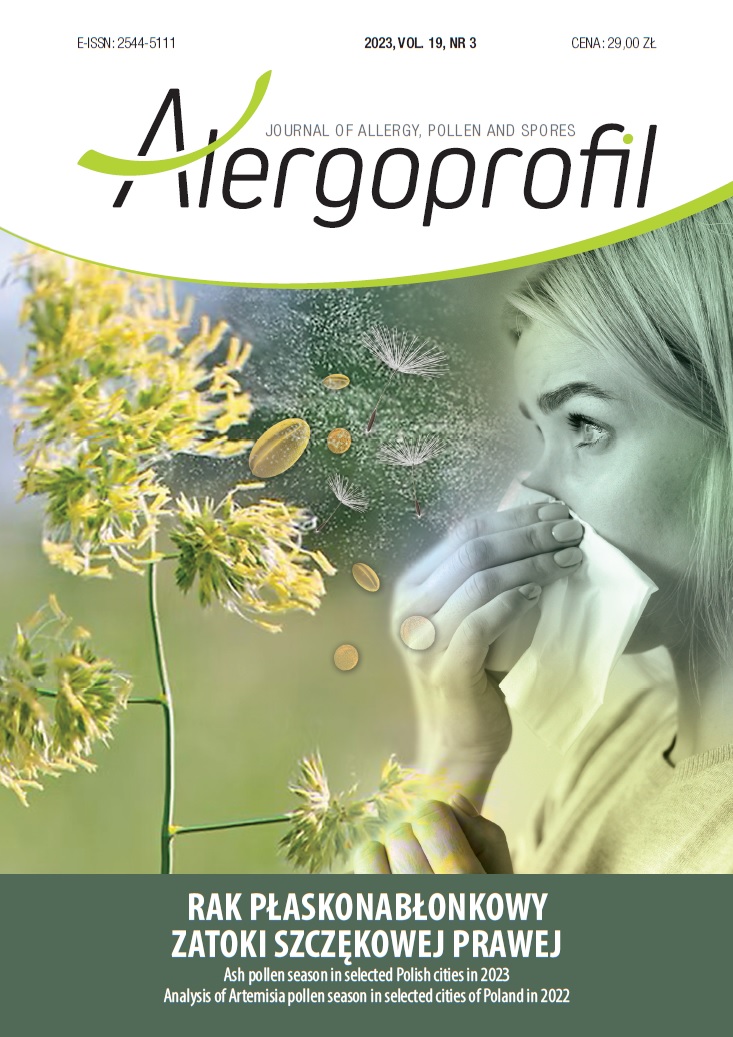Analysis of Artemisia pollen season in selected cities of Poland in 2022 Artykuł oryginalny
##plugins.themes.bootstrap3.article.main##
Abstrakt
Artemisia pollen is an important source of allergens responsible for inhalant allergy symptoms in late summer. The aim of this study was to compare the characteristics of the Artemisia pollen season in 2022 in selected cities located in different regions of Poland: Bialystok, Cracow, Lublin, Olsztyn, Opole, Piotrków Trybunalski, Sosnowiec, Szczecin, Warsaw and Wroclaw. Pollen concentrations were recorded using the volumetric method with a Hirst-type sampler operating in continuous volumetric mode. The beginning of Artemisia pollen season was in the second half of July in all monitored cities, and the end of the season at the latest at the end of the first half of September (14th in Piotrkow Trybunalski). The average length of the pollen season, determined with the 98% method, was 45 days. In all cities, maximum daily pollen concentrations were recorded in the first half of August, with Cracow, Lublin, Olsztyn, Sosnowiec and Warsaw in the first decade of the month. The highest daily concentration was recorded in Opole (78 pollen/m3), followed by Szczecin (72 pollen/m3). The average SPI for the Artemisia season was 486.7. Artemisia pollen production in analyzed cities in 2022 was lower than in years 2018–2020.
Pobrania
##plugins.themes.bootstrap3.article.details##

Utwór dostępny jest na licencji Creative Commons Uznanie autorstwa – Użycie niekomercyjne 4.0 Międzynarodowe.
Copyright: © Medical Education sp. z o.o. This is an Open Access article distributed under the terms of the Attribution-NonCommercial 4.0 International (CC BY-NC 4.0). License (https://creativecommons.org/licenses/by-nc/4.0/), allowing third parties to copy and redistribute the material in any medium or format and to remix, transform, and build upon the material, provided the original work is properly cited and states its license.
Address reprint requests to: Medical Education, Marcin Kuźma (marcin.kuzma@mededu.pl)
Bibliografia
2. Rutkowski L. Klucz do oznaczania roślin naczyniowych Polski niżowej. Państwowe Wydawnictwo Naukowe, Warszawa 2004.
3. Ralska-Jasiewiczowa M, Latałowa M, Wasylikowa K et al. (ed). Late Glacial and Holocene history of vegetation in Poland based on isopollen maps. Polish Academy of Sciences, Cracow 2004.
4. D’Amato G, Spieksma FT. Allergenic pollen in Europe. Grana. 2004; 30: 60-70.
5. Rapiejko P. Alergeny pyłku bylicy. In: Rapiejko P (ed). Alergeny pyłku roślin. Medical Education, Warszawa 2008.
6. Bogawski P, Grewling Ł, Frątczak A. Flowering phenology and potential pollen emission of three Artemisia species in relation to airborne pollen data in Poznań (western Poland). Aerobiologia. 2016; 32: 265-76.
7. Grewling Ł, Šikoparija B, Skjøth CA et al. Variation in Artemisia pollen seasons in central and eastern Europe. Agric For Meteorol. 2012; 160: 48-59.
8. Burbach GJ, Heinzerling LM, Edenharter G et al. GA(2)LEN skin test study II: clinical relevance of inhalant allergen sensitizations in Europe. Allergy. 2009; 64: 1507‐15.
9. Hoffmann K, Hilger Ch, Santos A et al. Molecular Allergology. User’s Guide 2.0. European Academy of Allergy and Clinical Immunology 2022.
10. Dramburg S, Chilger C, Santos AF et al. EAACI Molecular Allergology User’s Guide 2.0. EACCI Position Paper. Pediatr Allergy Immunol. 2023; 34: e13854.
11. Grewling Ł, Bogawski P, Kostecki Ł et al. Atmospheric exposure to the major Artemisia pollen allergen (Art v 1): Seasonality, impact of weather, and clinical implications. Sci Total Environ. 2020; 713: 136611.
12. Werfel T, Asero R, Ballmer-Weber BK et al. Position paper of the EAACI: food allergy due to immunological cross-reactions with common inhalant allergens. Allergy. 2015; 70: 1079-90.
13. Burge HA. Monitoring for airborne allergens. Ann Allergy. 1992; 9: 9-21.
14. Mandrioli P, Comtois P, Dominguez Vilches E et al. Sampling: Principles and Techniques. In: Mandrioli P, Comtois P, Levizzani V (ed). Methods in Aerobiology. Pitagora Editrice, Bologna 1998: 47-112.
15. Galán C, Smith M, Thibaudon M et al. Pollen monitoring: minimum requirements and reproducibility of analysis. Aerobiologia. 2014; 30: 385-95.
16. Emberlin J, Savage M, Jones S. Annual variations in grass pollen seasons in London 1961-1990: trends and forecast models. Clin Exp Allergy. 1993; 23(11): 911-8.
17. Galan C, Artaitti A, Bonnini M et al. Recommended terminology for aerobiological studies. Aerobiologia. 2017; 33: 293-5.
18. Rapiejko P, Stankiewicz W, Szczygielski K et al. Progowe stężenie pyłku roślin niezbędne do wywołania objawów alergicznych. Otolaryngol Pol. 2007; 61(4): 591-4.
19. Piotrowska-Weryszko K, Weryszko-Chmielewska E, Sulborska A et al. Comparison of Artemisia L. pollen concentrations and risk of development of allergy symptoms in different regions of Poland in 2020. Alergoprofil. 2020; 16(4): 27-33.
20. Puc M, Rapiejko P, Lipiec A et al. Mugwort pollen season in the air of Poland in 2019. Alergoprofil. 2019; 15(4): 23-8.
21. Weryszko-Chmielewska E, Piotrowska-Weryszko K, Woźniak A et al. Analysis of mugwort (Artemisia) pollen seasons in selected cities in Poland in 2018. Alergoprofil. 2018; 14(4): 117-22.
22. Spieksma FT, van Noort P, Nikkels AH. Influence of nearby stands of Artemisia on street-level versus roof-top-level ratio’s of airborne pollen quantities. Aerobiologia. 2000; 16: 21-4.

